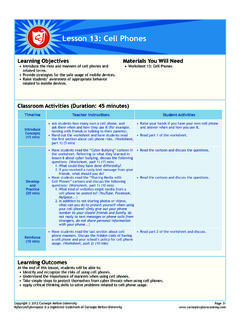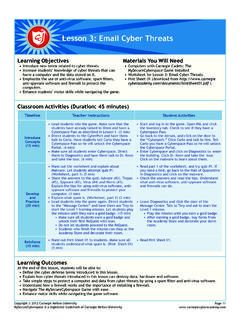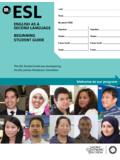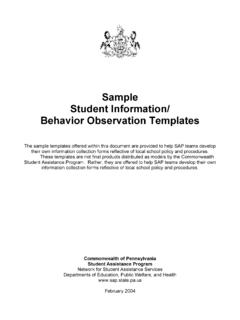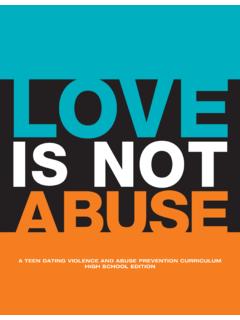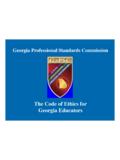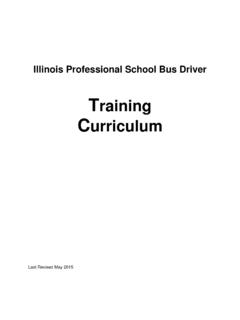Transcription of Lesson 12: Copyright and Plagiarism
1 Copyright 2012 Carnegie Mellon University MySecureCyberspace is a registered trademark of Carnegie Mellon UniversityPage Lesson 12: Copyright and PlagiarismLearning ObjectivesMaterials You Will NeedIntroduce students to Copyright issues. Introduce new terms and definitions. Emphasize illegal actions a student could take when using information from the students with safe computing steps when searching and using information over the 12: Copyright and Plagiarism Cards for the Flip the Card game (located in the Appendix). Print and cut them out before tennis balls labeled with the Threat and Safe words (located in the Appendix.)
2 Print on sticker paper to make them easy to stick to the tennis balls. Two baskets labeled Threat and Safe. Classroom Activities (Duration: 45 minutes)TimelineTeacher InstructionsStudent ActivitiesIntroduceConcepts (15 min)Hand out the worksheet to students and explain what Copyright is. Have them read the cartoon and discuss Copyright . (Worksheet, part 1) (7 min)Explain why Copyright is important. Explain how to appropriately use information and what Plagiarism and cyber piracy are and have students read the cartoon and discuss Plagiarism and cyber piracy. (Worksheet, part 2) (8 min)Emphasize that both activities are illegal and can lead to severe about Copyright and read the cartoon.
3 Discuss how to appropriately use information and data from the Internet. Read about Plagiarism and cyber piracy and read the cartoon. Discuss the consequences of Plagiarism and cyber and Practice (20 min)Distribute one Flip the Card card to each student. Have each student read their card out loud and have the class decide together if the action is legal or illegal. Discuss their answers. (13 min) Distribute the 16 tennis balls among the students. Have each student decide if the item is Safe or a Threat and toss the ball into the appropriate basket. If the student is unsure, have them place the ball between the two baskets and decide as a class where it belongs.
4 Discuss their answers. (12 min)Get a flip card. When it is your turn, read your card out loud and ask the class if is it legal or illegal. Get a labeled ball. When it is your turn, read the label out loud and toss the ball into the appropriate basket. If you are unsure, place the ball between the baskets and ask the class. Reinforce (10 min)Have the students read the last section of the worksheet, Using the Internet for Research, and discuss how to use it safely and appropriately. (Worksheet, part 3) (5 min)Read the worksheet and discuss how to use the Internet safely and OutcomesAt the end of this Lesson , students will be able to:Define new terms presented to them in this class.
5 Recognize legal and illegal actions when taking information over the Internet. Use sound judgment before accepting free offers over the Internet. Use sound judgment before downloading music, images or movies over the Internet. Understand the consequences of Plagiarism and cyber piracy. Recognize safe behavior when browsing and using information over the Internet. Copyright 2012 Carnegie Mellon University MySecureCyberspace is a registered trademark of Carnegie Mellon UniversityPage Worksheet 12: Copyright and Plagiarism1. What is Copyright ? Date:Name: Copyright is the creator s right of ownership to original material, such as an essay, web page, picture or song.
6 It gives the creator the right to take legal action against someone else who steals the material or claims they created it. Violating a Copyright is illegal. Don t use information from the Internet without citing who the author is. Don t download songs, games and movies that are copyrighted. Keep the following in mind when you use the Internet for research: Use search engines wisely and Look for safe and reliable Stay away from the four website Do not use information and data from the Internet without 4. giving the author credit. Officer Ward, Detention Center Security Officer2. Plagiarism and Cyber Piracy3.
7 Using the Internet for ResearchPlagiarism is using someone else s ideas or writing and claiming that it is yours. Cyber Piracy is when you use a computer to copy or share materials that are protected by Copyright without the creator s permission. Maya, Databank Supervisor 2012 Copyright Carnegie Mellon University. All Rights Reserved. 2012 Copyright Carnegie Mellon University. All Rights Reserved. 2012 Copyright Carnegie Mellon University. All Rights sentences on your friend s project and posting it online as your own legallegalIllegal?Illegal?Is the following actionor10 Posting an image online of a girl at school with some embarrassing commentslegallegalIllegal?
8 Illegal?Is the following actionor9 Buying items online using your Mom s credit cardlegallegalIllegal?Illegal?Is the following actionor11 Joining a Social Networking Web site using your friend s name and personal informationlegallegalIllegal?Illegal?Is the following actionor12 Trying to hack into your Teacher s accountlegallegalIllegal?Illegal?Is the following actionor14 Posting your class project online on a Social Networking Web sitelegallegalIllegal?Illegal?Is the following actionor13legallegalIllegal?Illegal?Is the following actionor15legallegalIllegal?Illegal?Is the following actionor16 Updating the classroom Web siteAttempting to access other students grades online 2012 Copyright Carnegie Mellon University.
9 All Rights sentences on your friend s project and posting it online as your own legallegalIllegal?Illegal?Is the following actionor10 Posting an image online of a girl at school with some embarrassing commentslegallegalIllegal?Illegal?Is the following actionor9 Buying items online using your Mom s credit cardlegallegalIllegal?Illegal?Is the following actionor11 Joining a Social Networking Web site using your friend s name and personal informationlegallegalIllegal?Illegal?Is the following actionor12 Trying to hack into your Teacher s accountlegallegalIllegal?Illegal?Is the following actionor14 Posting your class project online on a Social Networking Web sitelegallegalIllegal?
10 Illegal?Is the following actionor13legallegalIllegal?Illegal?Is the following actionor15legallegalIllegal?Illegal?Is the following actionor16 Updating the classroom Web siteAttempting to access other students grades online 2012 Copyright Carnegie Mellon University. All Rights an Email message to 100 students about a school eventlegallegalIllegal?Illegal?Is the following actionor18 Sending an Email message to 100 students out of angerlegallegalIllegal?Illegal?Is the following actionor17 Posting information on your school s Web site without permissionlegallegalIllegal?Illegal?Is the following actionor19 Posting your class dance video onlinelegallegalIllegal?
